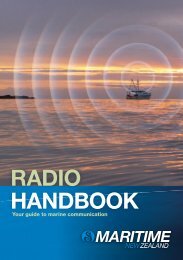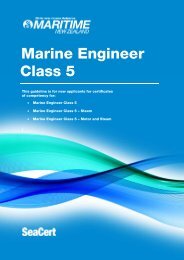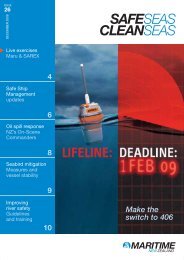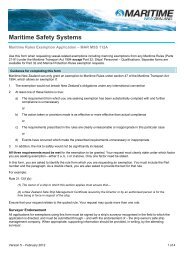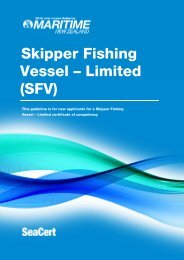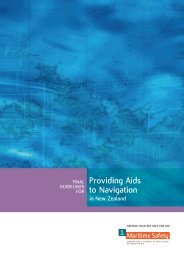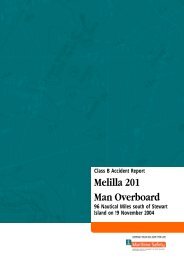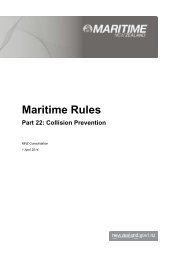Marine engineer MEC2 certificate MNZ guideline - Maritime New ...
Marine engineer MEC2 certificate MNZ guideline - Maritime New ...
Marine engineer MEC2 certificate MNZ guideline - Maritime New ...
Create successful ePaper yourself
Turn your PDF publications into a flip-book with our unique Google optimized e-Paper software.
2. Requirements (continued)<br />
2.2 Sea service<br />
Sea service requirements<br />
Your sea service must be relevant and appropriate to the requirements set out in the maritime rules. In<br />
practice, this means that you should:<br />
<br />
<br />
complete all of your sea service as an <strong>engineer</strong>ing officer (exercising the role of MEC 3) in the<br />
engine department, while holding your MEC 3 or equivalent <strong>certificate</strong> and<br />
complete at least 12 months’ approved sea service performing engine room watchkeeping duties<br />
on commercial ships or <strong>New</strong> Zealand warships with propulsion power of 750kW or more.<br />
You must also complete one of the following options:<br />
Option 1 (certifying motor propulsion): at least six months’ sea service on a motor ship (a ship with<br />
diesel main propelling machinery) with propulsion power of 750kW or more<br />
Option 2 (certifying steam propulsion): at least six months’ sea service on a steam ship with<br />
propulsion power of 750kW or more<br />
Option 3 (certifying combined motor and steam propulsion): at least six months’ sea service on motor<br />
ships with propulsion power of 750kW or more, and at least six months on steam ships with<br />
propulsion power of 750kW or more.<br />
All of your sea service must have been completed in the 10 years before your <strong>certificate</strong> is issued.<br />
Proving your sea service<br />
You are responsible for ensuring that your sea service is documented and verified by your ship’s master or<br />
company. The summary of sea service form on <strong>MNZ</strong>’s website can be used to help keep track of your sea<br />
service. (This form is not required for your <strong>certificate</strong> application.)<br />
To support your sea service, you must provide at least one of the following documents for each vessel you<br />
have served on:<br />
<br />
<br />
<br />
<strong>certificate</strong> of sea service<br />
completed seafarer’s record book<br />
discharge <strong>certificate</strong> or discharge book (if using a <strong>New</strong> Zealand discharge book, make sure you<br />
get the watchkeeping section signed off).<br />
If it is not included in any of the documents above, you must also provide a reference (on company<br />
letterhead), from the ship’s master, chief <strong>engineer</strong> or your employer. The reference must state the start and<br />
end dates of your service, your duties while in service, and your experience, conduct, sobriety and ability.<br />
Each of the documents you provide for each vessel must contain:<br />
<br />
<br />
<br />
<br />
<br />
your employer’s name and contact details<br />
the name, tonnage details and type of vessel (for example, passenger, non-passenger, fishing)<br />
the type of cargo carried and area of operation<br />
the dates you were employed and the sea time you completed<br />
your duties and the actual time spent on engine room watchkeeping.<br />
Any statutory declarations you have made are not acceptable as proof of your sea service.<br />
<strong>Marine</strong> Engineer Class 2 – Guidance for <strong>certificate</strong> of competency Page 4 of 20





